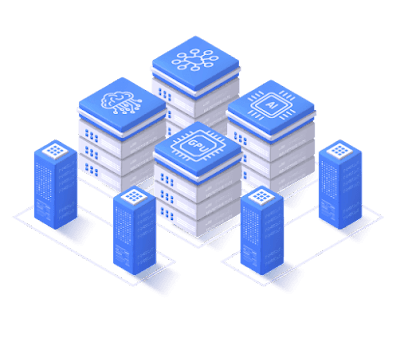The Benefits of GPU Servers for AI and Machine Learning
In recent years, artificial intelligence (AI) and machine learning (ML) have become increasingly popular technologies, with applications across a wide range of industries. These technologies rely heavily on complex calculations and data analysis, which can be extremely computationally intensive. This is where GPU servers come in - by offloading these calculations to specialized hardware, GPU servers can significantly improve the speed and efficiency of AI and ML workloads. In this blog, we'll explore some of the key benefits of using GPU servers for AI and ML.
- Faster processing times: GPU servers are
specifically designed to handle the type of calculations required for AI
and ML workloads. These calculations are often highly parallelizable,
meaning that they can be broken down into smaller pieces and run
simultaneously across multiple GPU cores. This results in much faster
processing times compared to CPU-based servers, which may only be able to
process one calculation at a time. In fact, some estimates suggest that
GPU servers can perform certain types of AI and ML calculations up to 100
times faster than traditional CPUs.
- Improved accuracy: In addition to
faster processing times, GPU servers can also improve the accuracy of AI
and ML models. This is because many AI and ML algorithms rely on matrix
multiplication, which is a key strength of GPUs. By offloading these
calculations to the GPU, AI and ML models can be trained more quickly and
accurately. This is particularly important for applications such as
computer vision and natural language processing, where accuracy is
critical.
- More cost-effective: While GPU servers
can be more expensive than traditional CPU-based servers, they can
actually be more cost-effective in the long run. This is because GPUs are
much more power-efficient than CPUs, which means that they can perform
more calculations per watt of power consumed. In addition, GPUs are
designed to handle highly parallel workloads, which means that they can
often replace multiple CPUs, resulting in lower hardware and maintenance
costs.
- Scalability: Another key benefit
of GPU servers is their scalability. Many cloud providers offer GPU
instances that can be scaled up or down as needed, depending on the size
of the workload. This means that businesses and organizations can start
small and scale up as needed, without having to invest in additional
hardware. In addition, GPU servers can often handle multiple workloads
simultaneously, which can help improve overall efficiency and reduce
costs.
- Versatility: Finally, GPU servers
are highly versatile and can be used for a wide range of applications
beyond AI and ML. For example, they can be used for scientific
simulations, rendering, and video processing. This means that businesses
and organizations can make use of their GPU servers even when they're not
running AI or ML workloads, making them a more valuable investment
overall.
The Future of GPU Servers: Trends to Watch
GPU servers have become an essential tool for businesses and organizations working in artificial intelligence (AI), machine learning (ML), and other data-intensive fields. With their ability to handle large amounts of data and perform complex calculations quickly and efficiently, GPU servers have become an important tool for driving innovation and improving business performance. In this blog, we'll explore some of the trends that are likely to shape the future of GPU servers.
- Increased Adoption of
AI and ML As AI and ML continue to gain traction across industries, we can
expect to see a corresponding increase in the adoption of GPU servers.
This is because GPU servers are specifically designed to handle the type
of calculations required for AI and ML workloads. As businesses seek to
gain a competitive edge through improved data processing capabilities, the
use of GPU servers is likely to become increasingly widespread.
- More Cloud-Based Solutions Cloud-based GPU servers are becoming more popular as businesses
seek to improve flexibility and reduce costs. Cloud-based GPU servers
allow businesses to quickly scale up or down depending on the size of the
workload, without having to invest in additional hardware. In addition,
cloud-based solutions can reduce the need for maintenance and upgrade
costs, as these are typically handled by the cloud provider.
- Increased Focus on
Security As the amount of data being processed by GPU servers increases,
security is becoming an increasingly important concern. Businesses and
organizations need to ensure that their data is protected from cyber
threats and other security risks. We can expect to see increased
investment in security measures such as encryption, multi-factor
authentication, and intrusion detection and prevention.
- Greater Integration
with Edge Computing Edge computing is becoming increasingly important as
businesses seek to process data closer to the source. This can help reduce
latency and improve overall performance. As such, we can expect to see
greater integration between GPU servers and edge computing technologies.
This will enable businesses to process data more quickly and efficiently,
even in remote or disconnected environments.
- Improved Energy Efficiency As the cost of energy continues to rise, businesses are looking for ways to reduce their energy consumption. GPU servers are already more energy-efficient than traditional CPU-based servers, but we can expect to see even greater improvements in energy efficiency in the future. This will be achieved through the use of new technologies such as liquid cooling, which can significantly reduce energy consumption.




Comments
Post a Comment